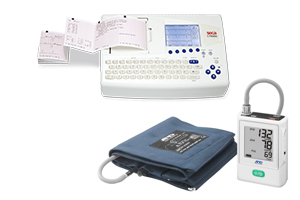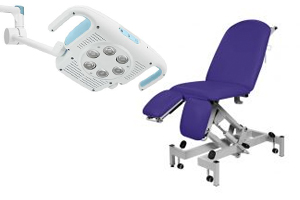We accept NHS purchase orders

Microlife WatchBP Office Vascular
Microlife 2nd Generation Office ABI Monitor
Screening for Peripheral Arterial Disease (PAD) and Atrial Fibrillation (AF).
Dual-cuff blood pressure monitor with Atrial Fibrillation (AF) detection and Ankle-Brachial Index (ABI) function.
The WatchBP Office ABI is a validated professional automatic office blood pressure device which can assess the ankle brachial index (ABI) fast and accurate.
Ankle Brachial Index
The Ankle Brachial Index (ABI) is the ratio of the blood pressure in the lower legs to the blood pressure in the arms. Blood pressure that is lower in the leg than in the arm indicates blocked arteries (peripheral artery disease) The ankle–brachial index represents a simple, reliable method for diagnosing peripheral arterial disease .
2nd Generation ABI monitor
At present, ABI is commonly determined with a Doppler device. However, measurement with a Doppler machine is very time consuming and requires skills from the observer. The Microlife 2nd Gen ABI monitor improves and eases the screening of peripheral vascular diseases. With this validated device the ABI can be determined accurately and significantly faster than with the Doppler machine. Another advantage of the 2nd Gen ABI monitor as compared to the Doppler Machine is that measurements are performed simultaneously and the method is much less influenced by the observer.
Features of the 2nd Gnereation ABI monitor
Inter-Arm-Difference (IAD)
Dual-cuff design for simultaneous measurement on both arms to assess the Inter-Arm-Difference (IAD).
Reliable AFIB screening
Screens for Atrial Fibrillation (AF) with high accuracy (sensitivity 98% - specificity 92%) as demonstrated in multiple comparative studies with 12-lead ECG.1-10
ABI assessment
Fast, easy, and accurate Ankle Brachial Index (ABI) assessment.11
Brachial-ankle PWV assessment (optional)
User-friendly with high reproducibility cuff-based brachial-ankle PWV measurement method to evaluate arterial stiffness.12
Non-invasive central blood pressure measurement (optional)
Determines blood pressure of the ascending aorta based on Pulse Volume Plethysmography (PVP) waveforms to help in making a reliable diagnosis of cardiovascular risk and hypertension.13
Flexible BPM schedule
Enables the physicians to adjust the settings of time intervals and numbers of consecutive measurements to comply with different guidelines.
Microlife Office Vascular can be upgraded
Allows on-demand paid upgrades of “PWV” (brachial-ankle pulse wave velocity (baPWV) and central blood pressure indices included).
Brachial-ankle PWV assessment (optional)
User-friendly with high reproducibility cuff-based brachial-ankle PWV measurement
method to evaluate arterial stiffness.12
Non-invasive central blood pressure measurement (optional)
Determines blood pressure of the ascending aorta based on Pulse Volume
Plethysmography (PVP) waveforms to help in making a reliable diagnosis of
cardiovascular risk and hypertension.13
Reference
1. Wiesel J, et al. The use of a modified sphygmomanometer to detect atrial fibrillation in outpatients. Pacing Clin Electrophysiol. 2004;27:639-43.
2. Stergiou GS, et al. Diagnostic accuracy of a home blood pr essure monitor to detect atrial fibrillation. Journal of human hypertension. 2009;23:654-8.
3. Wiesel J, et al. Detection of atrial fibrillation using a modified microlife blood pressure monitor. Am J Hypertens. 2009;22:848-52.
4. Wiesel J, et al. Screening for asymptomatic atrial fibrillation while monitoring the blood pressure at home: trial of regular versus irregular pulse for prevention of stroke (TRIPPS 2.0). Am J Cardiol. 2013;111:1598-601.
5. Kearley K, et al. Triage tests for identifying atrial fibrillation in primary care: a diagnostic accuracy study comparing single-lead ECG and mo dified BP monitors. BMJ Open. 2014;4:e004565.
6. Wiesel J, et al. Comparison of the Microlife blood pressure monitor with the Omron blood pressure monitor for detecting atrial fibrillation. Am J Cardiol. 2014;114:1046-8.
7. Gandolfo C, et al. Validation of a simple method for atrial fibrillation screening in patients with stroke. Neurol Sci. 2015;36:1675-8.
8. Chan PH, et al. Diagnostic performance of an automatic bloo d pressure measurement device, Microlife WatchBP Home A, for atrial fibrillation screening in a real-world primary care setting. BMJ Open. 2017;7:e013685.
9. Chan PH, et al. Head-to-Head Comparison of the AliveCor Hea rt Monitor and Microlife WatchBP Office AFIB for Atrial Fibrillation Screening in a Primary Care Setting. Circulation. 2017;135:110-2.
10. Verberk WJ, et al. Screening for atrial fibrillation with automated blood pressure measurement: Research evidence and practice recommendations. International journal of cardiology. 2016;203:465-73.
11. Kollias, A., et al., Automated determination of the ankle-b rachial index using an oscillometric blood pressure monitor: validation vs. Doppler measurement and cardiovascular risk factor proile. Hypertens Res, 2011. 34(7): p. 825-30.
12. Kollias, A., et al. Automated pulse wave velocity assessmen t using a professional oscillometric office blood pressure monitor. J Clin Hypertens. 2020;00:1–7.
13. Cheng, H.M., et al., Measurement accuracy of a stand-alone oscillometric central blood pressure monitor: a validation report for Microlife WatchBP Office Central. Am J Hypertens, 2013. 26(1): p. 42-50.
14. Kollias A, et al. Validation of the professional device for blood pressure measurement Microlife WatchBP Office in adults and children according to the American National Standards Institute/Association for the Advancement of Medical Instrumentation/International Organization for Standardization standard. Blood Press Monit. 2018 Apr;23(2):112-114.
15. Palatini P, Fania C, Gasparotti F. Accuracy of the WatchBP office ABI device for office blood pressure measurement over a wide range of arm sizes. Blood Press Monit. 2018 Apr;23(2):117-119.













